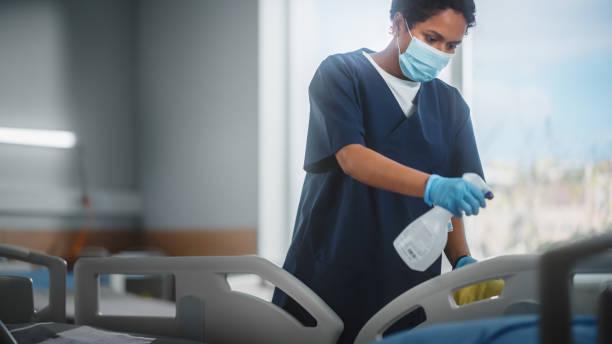Preventing Healthcare-Associated Infections (HAIs): Best Practices in Hospital Cleaning
Introduction:
In healthcare settings, preventing healthcare-associated infections (HAIs) is of utmost importance to safeguard the well-being of patients, visitors, and healthcare workers. Proper hospital cleaning practices play a crucial role in reducing the transmission of harmful pathogens and minimizing the risk of HAIs. This article focuses on best practices in hospital cleaning, highlighting key strategies to prevent infections and maintain a safe healthcare environment.

-
Comprehensive Cleaning Protocols:
To prevent HAIs effectively, hospitals must establish comprehensive cleaning protocols that encompass all areas and surfaces within the facility. This includes patient rooms, operating theaters, waiting areas, and high-touch surfaces such as doorknobs, handrails, and shared equipment. Cleaning protocols should outline specific procedures, cleaning agents, and frequency of cleaning to ensure thorough disinfection and removal of pathogens.
-
Adequate Training and Education:
Proper training and education are essential for hospital staff responsible for cleaning and disinfection. Healthcare facilities should invest in comprehensive training programs that cover infection control principles, proper use of cleaning agents, and correct techniques for surface disinfection. By ensuring staff members are knowledgeable and equipped with the necessary skills, hospitals can enhance the effectiveness of their cleaning practices and minimize the risk of cross-contamination.
-
Use of Effective Cleaning Agents:
Selecting appropriate cleaning agents is crucial in achieving effective disinfection. Hospitals should opt for EPA-approved disinfectants that are specifically designed to target a wide range of pathogens. It is important to follow manufacturer instructions for proper dilution, contact time, and application methods to maximize the efficacy of the cleaning agents. Regular evaluation of cleaning products is also essential to ensure their continued effectiveness in combating evolving pathogens.
-
Emphasis on High-Touch Surfaces:
High-touch surfaces, such as bed rails, call buttons, and shared medical devices, are hotspots for pathogen transmission. Hospitals should prioritize frequent cleaning and disinfection of these surfaces to minimize the risk of contamination. Using disposable wipes or microfiber cloths dedicated to each patient’s room can help prevent cross-contamination. In addition, implementing antimicrobial coatings on high-touch surfaces can provide an added layer of protection against pathogens.
-
Terminal Cleaning and Room Turnaround:
Proper cleaning between patient discharges is vital to maintain a clean and safe healthcare environment. Terminal cleaning involves a thorough disinfection of patient rooms, including all surfaces, furniture, and equipment. Hospitals should establish clear protocols for terminal cleaning, ensuring that all areas are adequately disinfected before a new patient is admitted. Time-efficient strategies, such as the use of UV light or hydrogen peroxide vapor systems, can enhance the effectiveness of terminal cleaning.
-
Hand Hygiene Promotion:
Hand hygiene is a cornerstone in preventing HAIs, and hospitals should promote its importance among both staff and visitors. Healthcare facilities should provide easy access to hand hygiene stations with alcohol-based hand sanitizers or soap and water. Regular training and reminders about proper hand hygiene techniques, including handwashing duration and the use of hand rubs, should be emphasized to all individuals present within the hospital setting.
-
Collaboration and Communication:
Preventing HAIs requires a multidisciplinary approach that involves collaboration and clear communication among different healthcare teams. Environmental services, infection control, nursing, and medical staff should work together to identify areas of improvement, address challenges, and develop strategies to enhance infection prevention efforts. Regular meetings, audits, and feedback mechanisms can facilitate ongoing improvement in hospital cleaning practices.
Conclusion:
Preventing healthcare-associated infections is a shared responsibility that requires a holistic approach to hospital cleaning. By implementing comprehensive cleaning protocols, providing adequate training, using effective cleaning agents, prioritizing high-touch surfaces, ensuring thorough terminal cleaning, promoting hand hygiene, and fostering collaboration, hospitals can significantly reduce the risk of HAIs. These best practices contribute to a safer healthcare environment, protecting the well-being of patients, visitors, and healthcare workers alike.
